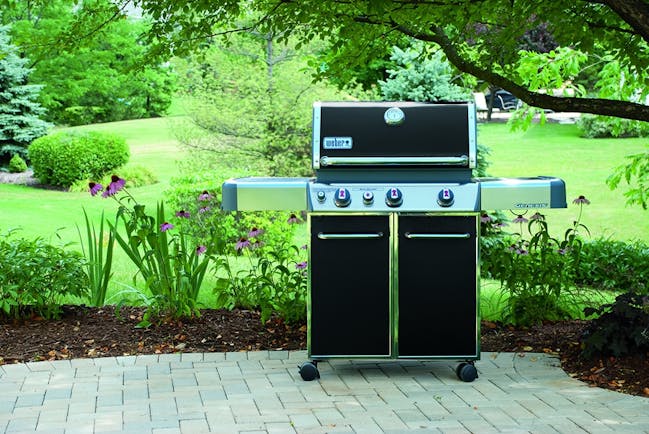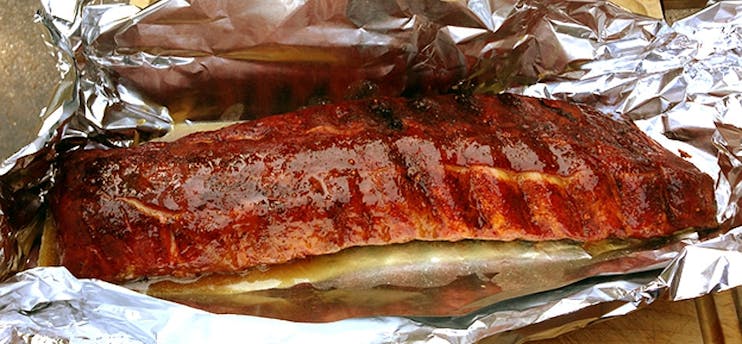Things Got Out Of Ham
Back in the 1970s, American banks enticed folks to open accounts by offering free toasters, transistor radios, eight-track tapes, and other irresistible treasures. Weber was a small company back then and I thought if we could convince banks to give away grills, we could grow our business fast.
My first lead was a bank in St. Charles, Illinois, then a small, bucolic town along the Fox River. Today it’s a western Chicago suburb regularly choked with traffic.
I managed to wrangle an appointment with none other than the president of the St. Charles National Bank, Mr. De Forest. Now, Mr. D was a rather intimidating pinstriped fellow—you know, the type who might glance over your loan application and negative net worth and, with an icy gaze over his half-glasses, unleash a resounding “No.”
Fortunately, I wasn’t asking for a loan. I had almost made the sale when he asked, “And how do you plan to deliver customers, cash in hand, to the doorstep of my bank?”
To this day I don’t know why I said, “We’ll offer a free barbecued ham sandwich to anyone who comes by to meet the friendly staff.” Mr. D loved the idea! We decided that Weber would do the grilling and the bank’s executives would serve the sandwiches.
I had three weeks to wonder what had possessed me to make such a crazy offer and to come up with a plan. Meanwhile, newspaper ads broke and suddenly all the local media wanted to cover the event. I began to get nervous. If there was too little ham, we would have a mad mob.
Too much ham would mean the bank’s employees would be eating leftovers for weeks—not the best PR for Weber.
Well, on Sandwich Day I hauled eight of our 36-inch Ranch® kettles (which can cook five whole hams at a time), fifty 18-pound hams, and 500 pounds of charcoal to the bank. A local bakery, though they thought I was nuts, agreed to deliver a half-truckload of freshly baked rye bread.
I fired up the grills at 7:00 a.m. and showed the bank executives, decked out in aprons and chef hats, how to make sandwiches while pitching the services of their bank with a smile. The first sandwiches were to be served at 11:00 a.m.
I suspected we were in trouble when we had to call the St. Charles police for traffic control just after 9:00 a.m. We started furiously carving ham at 10:30 a.m.
As I pulled a cooked ham off a grill, I put another one in its place and loaded more charcoal into the grill. We carved as fast as we could. Bank tellers formed a conga line of platter bearers, and the bank executives became covered in mustard.
By noon the police were getting nervous. Parking was full for a mile radius around the town and they had never even witnessed, let alone handled, gridlock. I was nervous, too. A half-truck of rye and 900 pounds of ham were going fast!
But Mr. D was having a ball talking to customers, cutting up with the local disk jockey, and handing out account applications. By 1:00 p.m. (closing time back then), they had opened more than 300 accounts.
Mr. D decided the bank would remain open until everyone received a sandwich. At my urging, he also sent some tellers to buy every ham they could find in St. Charles. We called the bakery for more rye bread.
Reinforcements from the Weber factory showed up with more charcoal, sharp knives, and new cutting boards. For the first time that day, I began to believe there wouldn’t be a riot.
The tellers came back with whole hams, rolled hams, and armloads of mustard jars, leaving empty grocery shelves in their wake. The second bread delivery made it through the police line just in time, and I kept stoking the kettles.
By 3:00 p.m. the line was down to mere hundreds and the bank had opened 500 accounts. We kept carving and the exhausted, mustard-covered bankers kept dispensing sandwiches.
Shortly after 5:00 p.m., our team of shell-shocked grillers and servers gave away the last free sandwich, broke out some beer, and started tallying up the day’s outcome. Some 1900 pounds of ham, 950 pounds of charcoal, one truckload of rye, and God knows how much mustard later, the bank had more than 650 new customers.
I had hoped to sell 40 or 50 grills to the St. Charles National Bank, but the order came to almost three truckloads.
If you ever need a recipe and a shopping list for feeding a small town ham sandwiches, check out my recipe below. And if you’re a bank executive and need some tips on pleasing customers, it’s been my experience that people take much more kindly to mustard-speckled aprons and a smile than an icy, pinstriped gaze over half-glasses. A free lunch doesn’t hurt, either.
Grilled Ham Sandwiches To Feed The Whole Town
Serves: about 1500
Cook: indirect/medium
8 barbecue grills, 36 inches in diameter each
½ ton hardwood charcoal briquets
Ingredients:
105 whole fully cooked hams, about 18 pounds each
190 loaves of fresh rye bread
6 gallons yellow mustard
10 people to carve hams
10 people to spread mustard
10 people to build sandwiches
8 -10 traffic cops
Plenty of parking
Instructions:
1. Pour 150 charcoal briquets into each grill; light briquets. Keep grill lids off until the briquets are lightly ashed over, 30 to 35 minutes. Place 75 briquets on opposite sides of each charcoal grate. Position cooking grates on grills so that hinges are above each pile of charcoal. Replenish charcoal every hour with 25 briquets per side.
2. Grill five hams on each grill over Indirect Medium heat until heated through to an internal temperature of 140°F, about 21/2 hours. Transfer from grills to cutting boards. Replace grilled hams with new ones. Repeat as necessary.
3. Carve the hams into thin slices. Reserve the bones for World’s Biggest Pot of Ham and Bean Soup, if desired. Build sandwiches with about 2 ounces of ham and 1 tablespoon of
mustard per sandwich. Keep the line moving. Dream about early retirement.
© 2001 Weber-Stephen Products Co. Recipe from Weber’s Big Book of Grilling. Used with permission.


